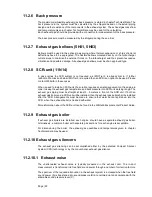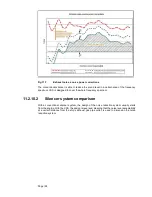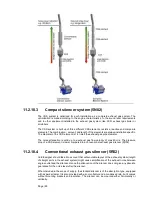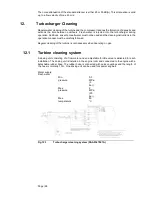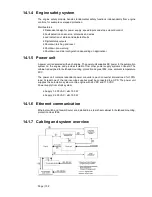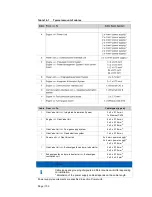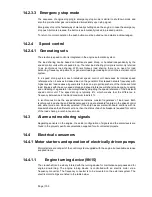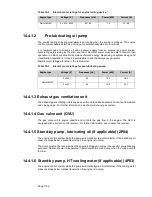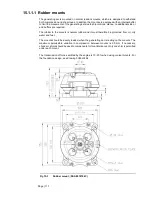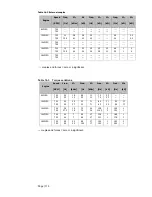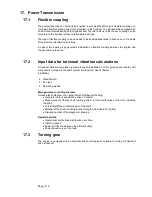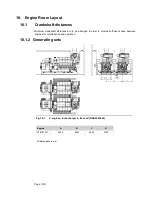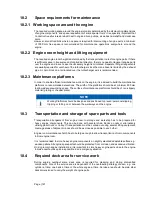
Page | 107
14.4.1.7 Stand-by pump, LT cooling water (if applicable) (4P05)
The engine control system starts the pump automatically via a motor starter, if the cooling water
pressure drops below a preset level when the engine is running.
14.4.1.8 Circulating pump for preheater (4P04)
The preheater pump shall start when the engine stops (to ensure water circulation through the
hot engine) and stop when the engine starts. The engine control system handles start/stop of
the pump automatically.
14.5
System requirements and guidelines for gas-electric
propulsion
Typical features to be incorporated in the propulsion control and power management systems
in a gas-electric ship:
1. The load increase program must limit the load increase rate during ship acceleration and
load transfer between generators according to the curves in chapter
2.2 Loading Capacity
.
●
Continuously active limit: “normal max. loading in operating condition”.
●
During the first 6 minutes after starting an engine: “preheated engine”
If the control system has only one load increase ramp, then the ramp for a preheated engine
is to be used.
The load increase rate of a recently connected generator is the sum of the load transfer
performed by the power management system and the load increase performed by the
propulsion control, if the load sharing is based on speed droop. In a system with
isochronous load sharing the loading rate of a recently connected generator is not affected
by changes in the total system load (as long as the generators already sharing load equally
are not loaded over 100%).
2.
Rapid loading according to the “emergency” curve in chapter
2.2 Loading Capacity
may
only be possible by activating an emergency function, which generates visual and audible
alarms in the control room and on the bridge.
3. The propulsion control should be able to control the propulsion power according to the
load increase rate at the gas generators. Controlled load increase with different number of
generators connected and in different operating conditions is difficult to achieve with only
time ramps for the propeller speed.
4. The load reduction rate should also be limited in normal operation. Crash stop can be
recognised by for example a large lever movement from ahead to astern.
5. The power management system performs loading and unloading of generators in a speed
droop system, and it usually also corrects the system frequency to compensate for the
droop offset, by adjusting the speed setting of the individual speed control units. The speed
reference is adjusted by sending an increase/decrease pulse of a certain length to the
speed control unit. The power management should determine the length of the
increase/decrease pulse based on the size of the desired correction and then wait for 30
seconds or more before performing a new correction, in particular when performing small
corrections.
The relation between duration of increase/decrease signal and change in speed reference
is usually 0.1 Hz per second. The actual speed and/or load will change at a slower rate.
6. The full output of the generator is in principle available as soon as the generator is
connected to the network, but only if there is no power limitation controlling the power
Summary of Contents for 31SG
Page 1: ...Page 1 PRODUCT GUIDE W rtsil 31SG...
Page 4: ...Page 4 This page intentionally left blank...
Page 8: ...Page 8 This page intentionally left blank...
Page 14: ...Page 14 This page intentionally left blank...
Page 21: ...Page 21 This page intentionally left blank...
Page 43: ...Page 43 This page intentionally left blank...
Page 49: ...Page 49 Fig 5 1 Flexible hoses...
Page 52: ...Page 52 This page intentionally left blank...
Page 58: ...Page 58 Fig 6 4 Gas valve unit reference P I diagram DAAF051037D...
Page 60: ...Page 60 Fig 6 7 Gas valve unit P I diagram open type DAAF085795A...
Page 64: ...Page 64 Fig 7 2 Lubricating oil system single engine wet sump DAAF301501B...
Page 65: ...Page 65 Fig 7 3 Lubricating oil system Gas multiple engines wet sump DAAF301500A...
Page 72: ...Page 72 This page intentionally left blank...
Page 77: ...Page 77 Fig 9 1 Example diagram for multiple main engines DAAF301505A...
Page 87: ...Page 87 This page intentionally left blank...
Page 98: ...Page 98...
Page 109: ...Page 109 This page intentionally left blank...
Page 113: ...Page 113 This page intentionally left blank...
Page 119: ...Page 119 This page intentionally left blank...
Page 122: ...Page 122 18 4 1 Service space requirement 18 4 1 1 Service space requirement engine...
Page 124: ...Page 124 This page intentionally left blank...
Page 127: ...Page 127 This page intentionally left blank...
Page 129: ...Page 129 This page intentionally left blank...
Page 132: ...W rtsil 31SG Product Guide Page 132 21 2 Collection of drawing symbols used in drawings...

